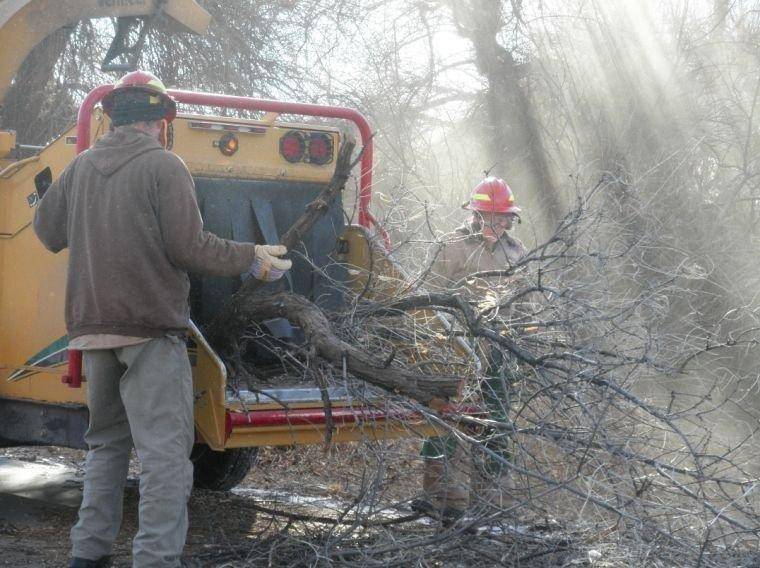The City of Moab voted to provide $10,000 in additional funding to remove invasive plant species from the Mill and Pack creeks at their city council meeting earlier this month. Rim to Rim Restoration, the non-profit arm of Wildland Scapes, will continue its work to thin Russian olive and tamarisk growth along the creeks and restore the area with native plants.
The objective is to improve wildlife habitat stretching through Moab to the Colorado River. Clearing the non-native trees is also meant to decrease the risk of fire and to improve the maintenance of the city’s floodways.
“We are working on Mill Creek from Matheson Wetlands to Rotary Park, and on Pack Creek from its confluence with Mill Creek to Spanish Trail Road,” said Kara Dohrenwend, the re-vegetation project manager and owner of Wildland Scapes.
Five different gaps in that span have been identified that still require invasive species removal, said Allison Lerch of Forestry, Fire and State Lands, who is helping to manage the cleanup.
Thus far the project has worked on 135 of the 260 total acres that it hopes to eventually clear. The goal is to get 75 percent of the previously Russian olive dominated parts of Mill Creek cleared. Eventually Rim to Rim Restoration hopes to create a healthy riparian corridor all the way from the upper La Sal watershed to the Scott M. Matheson Wetlands Preserve.
Moab first began working to remove the Russian olives and tamarisk from the creek corridors around 15 years ago, but due to intermittent funding, progress has been sporadic.
“Whenever they have been able to get grant money, they work on this stuff,” said Tim Higgs, the Grand County weed control supervisor.
Tamarisk and Russian olive were originally brought to Grand County to help stabilize the riverbanks, but they quickly began to crowd out and stifle native species. This has created issues with changing flood patterns, creating denser fuel ladders for fires through town and impacted animal habitats.
The invasive species removal project believes these issues are already starting to be solved in the areas where the removal of invasive plants has led to the regrowth of native vegetation.
“It’s good to have native species on landscapes as opposed to invasive, it helps with the hydrological side of things, since invasive species use more water,” said Justin Shannon, the Division of Wildlife Resource program manager for southeast Utah.
The project’s current treatment method moves through four steps: first, the large-scale removal and mulching of invasive species; second, large-scale removal and follow up treatment, with manual and herbicide weeding in areas where removal is expanding on past efforts; third, the removal of new sprouts and saplings; and finally, the stabilization of soil with native species.
The current work on the stream corridors is being done by a seven-man team headed by Clay Kark, which occasionally works in conjunction with a re-vegetation team the state has put together. Last week the team worked on a trail section behind the Chevron station and La Quinta on South Main Street and an area just upstream from the bike park and across from the hospital near 500 West.
The need for clearing out the creek areas has been driven home by the several fires that have started in these areas over the last few years, according to the Wildland Scapes proposal presented to the City of Moab. These fires have caused landowners to seriously address the problems of over vegetation in their creek areas.
“There is extreme value in this because the Wild Fire Protection Plan has identified Mill and Pack Creek as two of the main fire corridors,” Lerch said.
The city-designated flood control zone is the main area where the project is focusing in town.
An impressive number of stakeholders have been involved in the process of clearing and re-vegetation. Rim to Rim has been working in conjunction with the fire and forestry departments, as well as with state lands and approximately 30 private landowners. The project tries to match the grant money it receives with local support in the form of money from the city, and labor and financial donations from landowners.
A good deal of effort has gone into working with the landowners so that the project can spread to connect the cleared areas. When a landowner agrees to join, Dohrenwend and Lerch work with them to evaluate their situation and draw up a management plan which, though time consuming, has proven very successful. The project now has incorporated over 40 private parcels of land.
“It takes a lot of coordination to see the success of the project,” Lerch said. “A lot of people in the community hold stake in both the Mill and Pack Creek watersheds. It has been quite a feat to get the project to where it is now.”
There is a risk that the loss of screening along these corridors will affect wildlife migrations, Shannon said, but the project has attempted to minimize this by never working on more than 10 consecutive acres at one time.
The temporary loss of tree and shrubs may adversely affect bird habitat in the short-term. However, a range of birds, including raptors, screech owls and northern orioles, should benefit in the long-term from the reassertion of native vegetation.
Rim to Rim Restoration plans to treat 75 percent of the Mill Creek corridor by June. This should reduce the Russian olive seeding by more than 50 percent, with the goal that the Matheson Wetlands should be nearly Russian olive free in the foreseeable future.
The project has enough funding to work through the end of this fiscal year, but a Utah Watershed Restoration Initiative (WRI) conference this week in Green River will determine whether the project continues to receive WRI grant money in the coming year.
To read more from the Moab Sun News click here.
В

